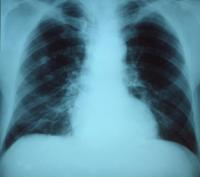
Researchers report they have found a way to disrupt the spread of antibiotic-resistance genes among S. pneumoniae bacteria, which can contribute to pneumonia (pictured), meningitis and other dangerous ailments. The bacterium Streptococcus pneumoniae – which can cause pneumonia, meningitis, bacteremia and sepsis – likes to share its antibiotic-defeating weaponry with its neighbors. Individual cells can pass resistance genes to one another through a process called horizontal gene transfer, or by "transformation," the uptake of DNA from the environment.
Now researchers report that they can interrupt the cascade of cellular events that allows S. pneumoniae to swap or suck up DNA. The new findings, reported in the journal PLoS ONE, advance the effort to develop a reliable method for shutting down the spread of drug resistance in bacteria.
"Within the last few decades, S. pneumoniae has developed resistance to several classes of antibiotics," said University of Illinois pathobiology professor Gee Lau, who led the study. "Importantly, it has been shown that antibiotic stress – the use of antibiotics to treat an infection – can actually induce the transfer of resistance genes among S. pneumoniae. Our approach inhibits resistance gene transfer in all strains of S. pneumoniae, and does so without increasing selective pressure and without increasing the likelihood that resistant strains will become dominant."
Lau and his colleagues focused on blocking a protein that, when it binds to a receptor in the bacterial cell membrane, spurs a series of events in the cell that makes the bacterium "competent" to receive new genetic material. The researchers hypothesized that interfering with this protein (called CSP) would hinder its ability to promote gene transfer.
In previous work published late last year in the journal PLoS Pathogens, Lau's team identified proteins that could be made in the lab that were structurally very similar to the CSP proteins. These artificial CSPs can dock with the membrane receptors, block the bacterial CSPs' access to the receptors and reduce bacterial competence, as well as reducing the infectious capacity of S. pneumoniae.
In the new study, the researchers fine-tuned the amino acid structure of more than a dozen artificial CSPs and tested how well they inhibited the S. pneumoniae CSPs. They also tested their ability (or, more desirably, their inability) to mimic the activity of CSPs in bacterial cells.
"The chemical properties of individual amino acids in a protein can greatly influence the protein's activity," Lau said.
The team identified several artificial CSPs that both inhibited the bacterial CSPs and reduced S. pneumoniae competence by more than 90 percent.
"This strategy will likely help us reduce the spread of antibiotic-resistance genes among S. pneumoniae and perhaps other species of streptococcus bacteria," Lau said. Source : University of Illinois at Urbana-Champaign
 Print Article
Print Article Mail to a Friend
Mail to a Friend
